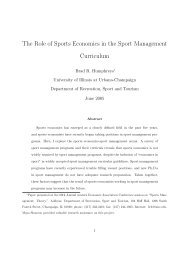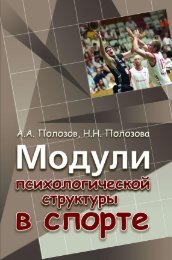Create successful ePaper yourself
Turn your PDF publications into a flip-book with our unique Google optimized e-Paper software.
12 • ESCRIME INTERNATIONALE<br />
LES CHAMPIONNATS DU MONDE DE LEIPZIG • THE LEIPZIG WORLD<br />
The <strong>2005</strong> World Championships held in<br />
<strong>Leipzig</strong> confirmed the exceptional talent<br />
of great fencers, already recognised in<br />
the past. This was the case for Russian<br />
épée fencer Kolobkov, Italian foil fencers<br />
Vezzali and Sanzo, Romanian sabre<br />
fencer Covaliu and Russia’s Podzniakov<br />
(outstanding in the team competition),<br />
and even French sabre fencer Anne-Lise<br />
Touya who, although only 24 years old,<br />
has already won two gold medals in<br />
World Championships. Overall, 15<br />
countries won the 42 medals on offer.<br />
This represents a traditional distribution<br />
between Europe, Asia and America.<br />
With 10 medals (4 of them gold), France<br />
dominated the event, ahead of Russia<br />
with 7 medals (2 gold, 3 silver and<br />
2 bronze) and Italy with 6 medals (2<br />
gold, 2 silver and 2 bronze). Germany<br />
(2 silver and 2 bronze medals) was<br />
hoping for a better result as they had<br />
the home advantage. With one single<br />
medal (silver in men’s foil), China was<br />
outclassed by another Asian nation:<br />
South Korea won the women’s foil<br />
competition and provided Asia with the<br />
first ever senior team title in a world<br />
championship. Finally, the United<br />
States, very subdued during the previous<br />
five days, made a partial recovery with<br />
the last minute gold medal won by<br />
their women sabre fencers in the final<br />
event of the <strong>2005</strong> world championships.<br />
More generally, the technical<br />
innovations in foil gave this traditional<br />
weapon back its original purpose:<br />
priority given to the “in-line” position.<br />
The German organisers should also be<br />
congratulated: the room’s display, its<br />
decor and specific lighting made it<br />
possible for the spectators to attend a<br />
very well-directed show, and for<br />
television viewers to get passionate<br />
about fencing. This is also due to the<br />
talent of the television director who was<br />
able to find new camera angles to show<br />
the emotion on the fencers’ faces.<br />
Similarly, the possibility of following the<br />
world championships live on the<br />
website of the FIE was a great success. It<br />
is now up to Turin to take over and<br />
address the challenge<br />
of upping the ante in 2006.<br />
THE CROWNING OF LEGENDARY CHAMPIONS<br />
THE BENEFITS OF AGE<br />
They are in their prime. Their fencing technique<br />
hasn’t aged one bit. Their names:<br />
Pavel Kolobkov, 36, Valentina Vezzali, 31 or<br />
Stanislaw Podzniakov, 33. They are épée, foil or<br />
sabre fencers and, in <strong>Leipzig</strong>, they reached the<br />
highest step on the podium, thus representing<br />
the glory of being in their thirties. Russian épée<br />
fencer Pavel Kolobkov is a phenomenon in<br />
himself. Already world champion in 1993,<br />
1994 and 2002, 2000 Olympic champion in<br />
Sydney, he seems so resilient that he has the<br />
physical appearance and fencing technique of<br />
a younger champion. This is probably his most<br />
impressive feature: time seems to have no<br />
impact on him. In <strong>Leipzig</strong>, he certainly did not<br />
outclass his rivals: 15 – 14 victory in the first<br />
elimination round against Italy’s Alessandro<br />
Bossalini, 11-10 in the last sixteen against<br />
Germany’s Sven Schmid, 11-10 again in the<br />
semi-final against Holland’s Bas Verwijlen, and<br />
15-14 (really 18-17 if you take into consideration<br />
the last three double hits) in the final<br />
against France’s Fabrice Jeannet. But each time<br />
he was able to seize the opportunity at the<br />
right moment, and this has nothing to do with<br />
a mere streak of good luck. He has an innate<br />
sense of the right tactical move at the right<br />
time. He can imagine anything, create anything,<br />
and hope to do anything as technically<br />
he knows it all.<br />
Future generations will be sorry not to have<br />
witnessed the art of Pavel Kolobkov. He is a<br />
model for everyone. The other hero of the épée<br />
final, France’s Fabrice Jeannet (world champion<br />
in 2003), equally magnificent, paid him a glowing<br />
tribute in French newspaper L’Equipe of<br />
17 October, for everyone to read: “His record<br />
of achievements is one of the most impressive,<br />
■ Finale au fleuret féminin par équipes : à gauche la<br />
Coréenne Jung Kil Ok, à droite la Roumaine Cristina Ghita.<br />
■ Final of the women’s team competition in foil: Korea’s<br />
Jung Kil Ok, left, and Romania’s Cristina Ghita, right.<br />
■ Final al florete femenino por equipos: a la izquierda la<br />
Coreana Jung Kil Ok, a la derecha la Rumana Cristina Ghita.<br />
if not the best, in fencing. He has been around<br />
for twenty years, he always gets the results, he<br />
is always in great shape, and he has won everything,<br />
and done so with style. He is in control<br />
of all aspects of the game, both technically and<br />
physically, he understands it all. Therefore I<br />
cannot but admire him. He is a pleasure to<br />
watch when he fights, he is highly efficient.<br />
Fighting against him is a joy, even though I<br />
have never managed to beat him”. After a<br />
total of twelve double hits, all cleverly provoked,<br />
Pavel Kolobkov was able to achieve his<br />
fourth individual title and everything that goes<br />
with it.<br />
In <strong>Leipzig</strong>, however, Fabrice Jeannet, 23, added<br />
the gold of the team competition to the silver<br />
of the individual event, with an admirable and<br />
unusual sense of fair play. In the quarterfinal,<br />
fate had played a cruel trick on him by drawing<br />
him against his elder brother Jérôme, an excellent<br />
fencer himself for the past few years, but<br />
who seemed petrified by this battle against his<br />
brother. Partnered with Eric Boisse and Ulrich<br />
Robeiri, the Jeannet brothers played a major<br />
part, four days later, in France’s world title in<br />
the team event, following the Olympic title<br />
won last year in Athens. This time, youth (the<br />
other three French fencers are under 25) prevailed<br />
and the demonstration was just as conclusive:<br />
they were technically and collectively<br />
superior and consistent. French épée naturally<br />
rose to the level of the best teams of all times.<br />
Its valiant knights managed to wipe out all

















